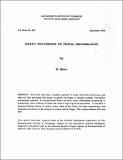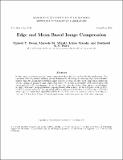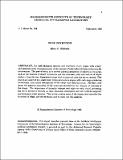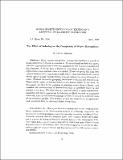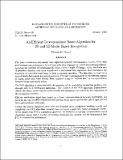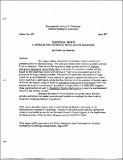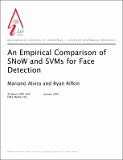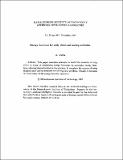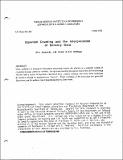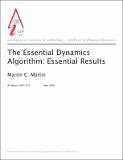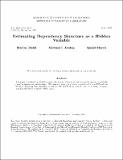Browsing AI Memos (1959 - 2004) by Title
Now showing items 301-320 of 1217
-
Early Processing of Visual Information
(1975-12-01)The article describes a symbolic approach to visual information processing, and sets out four principles that appear to govern the design of complex symbolic information processing systems. A computational theory of ... -
Edge and Mean Based Image Compression
(1996-11-01)In this paper, we present a static image compression algorithm for very low bit rate applications. The algorithm reduces spatial redundancy present in images by extracting and encoding edge and mean information. Since ... -
Edge Detection
(1985-09-01)The goal of vision is to recover physical properties of objects in a scene, such as the location of object boundaries and the structure, color, and texture of object surfaces, from the two-dimensional image that is ... -
The Effect of Indexing on the Complexity of Object Recognition
(1990-04-01)Many current recognition systems use constrained search to locate objects in cluttered environments. Previous formal analysis has shown that the expected amount of search is quadratic in the number of model and data features, ... -
Efficiency of Equivalence Algorithms
(1972-04-01)This paper was first presented at the Symposium on Complexity of Computer Computations, IBM Thomas J. Watson Research Center, Yorktown Heights, New York, on March 22, 1972. The equivalence problem is to determine the ... -
An Efficient Correspondence Based Algorithm for 2D and 3D Model Based Recognition
(1990-10-01)A polynomial time algorithm (pruned correspondence search, PCS) with good average case performance for solving a wide class of geometric maximal matching problems, including the problem of recognizing 3D objects from ... -
Electrical Design: A Problem for Artificial Intelligence Research
(1977-06-01)This report outlines the problem of intelligent failure recovery in a problem-solver for electrical design. We want our problem solver to learn as much as it can from its mistakes. Thus we cast the engineering design ... -
An Electronic Market-Maker
(2001-04-17)This paper presents an adaptive learning model for market-making under the reinforcement learning framework. Reinforcement learning is a learning technique in which agents aim to maximize the long-term accumulated rewards. ... -
Elementary Geometry Theorem Proving
(1973-04-01)An elementary theorem prover for a small part of plane Euclidean geometry is presented. The purpose is to illustrate important problem solving concepts that naturally arise in building procedural models for mathematics. -
EMACS Manual for ITS Users
(1981-10-01)A reference manual for the extensible, customizable, self-documenting real-time display editor. This manual corresponds to EMACS version 162. -
EMACS Manual for TWENEX Users
(1983-03-01)A reference manual for the extensible, customizable, self-documenting real-time display editor. This manual corresponds to EMACS version 162. -
EMACS: The Extensible, Customizable, Self-Documenting Display Editor
(1981-03-01)EMACS is a display editor which is implemented in an interpreted high level language. This allows users to extend the editor by replacing parts of it, to experiment with alternative command languages, and to share ... -
An Empirical Comparison of SNoW and SVMs for Face Detection
(2001-01-01)Impressive claims have been made for the performance of the SNoW algorithm on face detection tasks by Yang et. al. [7]. In particular, by looking at both their results and those of Heisele et. al. [3], one could infer that ... -
Energy Functions for Early Vision and Analog Networks
(1987-11-01)This paper describes attempts to model the modules of early vision in terms of minimizing energy functions, in particular energy functions allowing discontinuities in the solution. It examines the success of using ... -
Equation Counting and the Interpretation of Sensory Data
(1981-06-01)Many problems in biological information processing require the solution to a complex system of equations in many unknown variables. An equation-counting procedure is described for determining whether such a system of ... -
An Equivalence Between Sparse Approximation and Support Vector Machines
(1997-05-01)In the first part of this paper we show a similarity between the principle of Structural Risk Minimization Principle (SRM) (Vapnik, 1982) and the idea of Sparse Approximation, as defined in (Chen, Donoho and Saunders, ... -
Equivalence Problems in a Model of Computation
(1967-08-01)A central problem in the mathematical teory of computers and computation is to find a suitable framework for expressing the ececution of a computer program by a computer. Within the framework we want to be alble to provide ... -
The Essential Dynamics Algorithm: Essential Results
(2003-05-01)This paper presents a novel algorithm for learning in a class of stochastic Markov decision processes (MDPs) with continuous state and action spaces that trades speed for accuracy. A transform of the stochastic MDP ... -
Estimating Dependency Structure as a Hidden Variable
(1998-09-01)This paper introduces a probability model, the mixture of trees that can account for sparse, dynamically changing dependence relationships. We present a family of efficient algorithms that use EM and the Minimum Spanning ... -
Estimating Dependency Structure as a Hidden Variable
(1997-06-01)This paper introduces a probability model, the mixture of trees that can account for sparse, dynamically changing dependence relationships. We present a family of efficient algorithms that use EMand the Minimum Spanning ...

